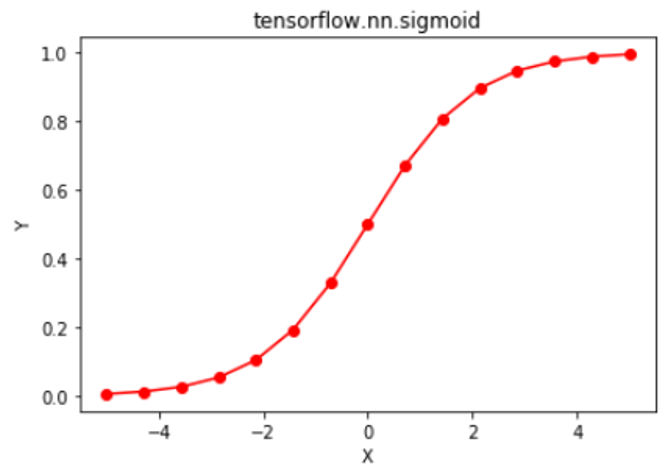Python | Tensorflow nn.sigmoid()
Last Updated :
12 Dec, 2021
Tensorflow is an open-source machine learning library developed by Google. One of its applications is to develop deep neural networks.
The module tensorflow.nn provides support for many basic neural network operations.
One of the many activation functions is the sigmoid function which is defined as  .
.
Sigmoid function outputs in the range (0, 1), it makes it ideal for binary classification problems where we need to find the probability of the data belonging to a particular class. The sigmoid function is differentiable at every point and its derivative comes out to be  . Since the expression involves the sigmoid function, its value can be reused to make the backward propagation faster.
. Since the expression involves the sigmoid function, its value can be reused to make the backward propagation faster.
Sigmoid function suffers from the problem of “vanishing gradients” as it flattens out at both ends, resulting in very small changes in the weights during backpropagation. This can make the neural network refuse to learn and get stuck. Due to this reason, usage of the sigmoid function is being replaced by other non-linear functions such as Rectified Linear Unit (ReLU).
The function tf.nn.sigmoid() [alias tf.sigmoid] provides support for the sigmoid function in Tensorflow.
Syntax: tf.nn.sigmoid(x, name=None) or tf.sigmoid(x, name=None)
Parameters:
x: A tensor of any of the following types: float16, float32, float64, complex64, or complex128.
name (optional): The name for the operation.
Return type: A tensor with the same type as that of x.
Code #1:
Python3
import tensorflow as tf
a = tf.constant([1.0, -0.5, 3.4, -2.1, 0.0, -6.5], dtype = tf.float32)
b = tf.nn.sigmoid(a, name ='sigmoid')
with tf.Session() as sess:
print('Input type:', a)
print('Input:', sess.run(a))
print('Return type:', b)
print('Output:', sess.run(b))
|
Output:
Input type: Tensor("Const_1:0", shape=(6, ), dtype=float32)
Input: [ 1. -0.5 3.4000001 -2.0999999 0. -6.5 ]
Return type: Tensor("sigmoid:0", shape=(6, ), dtype=float32)
Output: [ 0.7310586 0.37754068 0.96770459 0.10909683 0.5 0.00150118]
Code #2: Visualization
Python3
import tensorflow as tf
import numpy as np
import matplotlib.pyplot as plt
a = np.linspace(-5, 5, 15)
b = tf.nn.sigmoid(a, name ='sigmoid')
with tf.Session() as sess:
print('Input:', a)
print('Output:', sess.run(b))
plt.plot(a, sess.run(b), color = 'red', marker = "o")
plt.title("tensorflow.nn.sigmoid")
plt.xlabel("X")
plt.ylabel("Y")
plt.show()
|
Output:
Input: Input: [-5. -4.28571429 -3.57142857 -2.85714286 -2.14285714 -1.42857143
-0.71428571 0. 0.71428571 1.42857143 2.14285714 2.85714286
3.57142857 4.28571429 5. ]
Output: [ 0.00669285 0.01357692 0.02734679 0.05431327 0.10500059 0.19332137
0.32865255 0.5 0.67134745 0.80667863 0.89499941 0.94568673
0.97265321 0.98642308 0.99330715]

Share your thoughts in the comments
Please Login to comment...